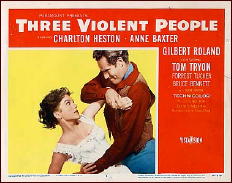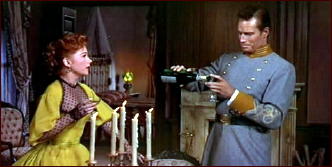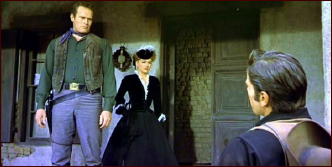Sun 6 Jul 2014
A Western Movie Review: THREE VIOLENT PEOPLE (1956).
Posted by Steve under Reviews , Western movies[3] Comments
THREE VIOLENT PEOPLE. Paramount Pictures, 1956. Charlton Heston, Anne Baxter, Gilbert Roland, Tom Tryon, Forrest Tucker, Bruce Bennett, Elaine Stritch, Barton MacLane, Peter Hansen, John Harmon, Ross Bagdasarian, Robert Blake, Jamie Farr. Screenplay: James Edward Grant. Director: Rudolph Maté.
When Captain Colt Saunders (Charlton Heston) comes home to Texas after the Civil War (he was on the losing side), he finds that carpetbaggers have infested the state and they have eyes on his old family ranch, all he has left in the world. But before he makes his way home, he somehow manages to find himself a wife, Lorna Hunter (Anne Baxter).
It turns out, although he does not know it, that Ms Hunter has something a bit more than a shady past, but she is willing to take the gamble that no one will recognize her on the Bar-S Ranch and miles away from the rest of the world.
It also turns out that Captain Saunders, a most righteous man, has a brother (Tom Tryon), who has only one arm, his left, and who is bitter about it. The local tax commissioner and his deputy, Northerners both (Bruce Bennett and Forrest Tucker) have their eyes on the ranch, and are far from scrupulous in their attempt to follow through on their ambitions.
Running the ranch in the captain’s absence has been Innocencio Ortega (a most elegant Gilbert Roland, even in working clothes) and his five sons, three of whom are played by young actors who went on to even more fame later in their careers (see the tail end of the credits above).
These are all the important threads of the story, and of course one of the tactics the crooked land-grabbers have at their disposal is using the fact that they know of Lorna’s past, and they are not at all reticent in revealing the secret to the tough but stubbornly aristocratic Captain Saunders.
He does not take the news well. Nor does he take kindly to his brother turning against him. Charlton Heston is a good actor, but he can turn hammy at times, and here is one of those times. He also plays Captain Saunders as rather slow when it comes to the thinking department — a man whose mind is rather dim, to put it bluntly — and it does seem to fit the character.
I think that Heston and Tryon do resemble each other enough to be brothers, as was not the case in Saddle the Wind, which Jon reviewed here a while ago, in which Robert Taylor and John Cassevetes were also supposed to be brothers, and not succeeding very well at it.
The color photography in Three Violent People is wonderful — I leave to you to decide who the three people are; I still haven’t figured that out — but while all of the ingredients are there, with several very tense scenes leading up to the finale, the ending simply isn’t up to the job. It’s forced and it’s overly moralistic, and it didn’t have to be either one.
It’s a case of being almost a great western, but it ends up barely holding onto its status as a very good one.




July 6th, 2014 at 12:13 am
By some sort of strange coincidence, just before Jon and I watched this one, we finished watching THEY DRIVE BY NIGHT, which we had started the night before. What struck us both as remarkable is that in THREE VIOLENT PEOPLE, Tom Tyron gets along quite well with only one arm, and in the other movie, it’s Humphrey Bogart’s character who loses one.
July 6th, 2014 at 12:21 am
I quite like Charlton Heston and think he’s been considerably underrated by a lot of critics, especially of late. That said, I think that Gilbert Roland was actually much better in this than Heston was. He just came across as fitting his part perfectly, while Heston at times just didn’t seem to act the way in which you would imagine a former Confederate officer might have, particularly in his overeagerness to marry Baxter’s character who, five minutes prior, he thought was stealing from him.
July 8th, 2014 at 7:09 pm
This one should be much better than it is, but for whatever reason it isn’t. Heston’s southern accent is none too consistent or even vaguely Texan, and as Jonathan says Roland is far better, and might have made for a better protagonist.
I always wondered if this helped Disney to cast Tryon as Texas John Slaughter though.
With that cast this should have been much better.